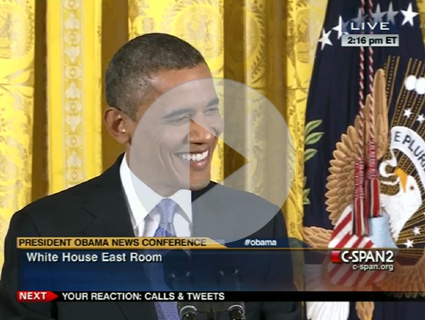It was halting, and hardly eloquent. He seemed rusty talking about the issue, even saying “carbons” at one point instead of “carbon.” But nonetheless, in a White House press conference last Wednesday, President Obama went the furthest he has gone yet in laying out a climate change agenda for his second term.
“I am a firm believer that climate change is real, that it is impacted by human behavior and carbon emissions,” Obama said, “and as a consequence, I think we’ve got an obligation to future generations to do something about it.” The president then went on to discuss his plans to pursue both short- and long-term climate solutions—and most of all, emphasized creating “a conversation across the country” to educate Americans and determine what they’re really ready to commit to, policywise, on the issue.
There were few specifics of the sort that climate watchers wanted to hear, however—and they were justly incensed the next day, when White House press secretary Jay Carney dismissed both the notion of a carbon tax, and tying global warming to Superstorm Sandy (actually, the connection is quite clear and unambiguous). Nonetheless, Obama’s halting words reflect a stark political reality: Thanks to Sandy, we’re only now taking baby steps back towards the political traction that we had obtained four years ago, when cap and trade legislation really seemed achievable—before the Category 5 intensification of tea party science denial. Before the climate silence.
Despite these setbacks, however, there are many reasons to think that Obama’s administration in its second term can do a great deal to make progress on climate change. And that progress will be much stronger if Obama, as his words on Wednesday seemed to promise, actually takes the lead.
“This is a process,” says Eric Pooley, author of The Climate War and former deputy editor of Business Week, and now a senior vice president at the Environmental Defense Fund. “It took a while to get to this place where climate silence had settled over our politics, to the point where the issue never came up in the debates. And it’s going to take a while to get back to a grown-up conversation about solutions.”
“Obama leading the way back to that grown-up conversation is crucial,” Pooley adds. “And he has everything he needs to do that.”
The situation is growing ever more urgent. Sometime in Obama’s next term, we’re likely to pass a threshold that, for the scientifically attuned, is terrifying: carbon dioxide concentrations of 400 parts per million in the atmosphere. That’s already far more atmospheric carbon than at any time in the modern history of the planet, and well past the 350 parts per million threshold that NASA’s James Hansen has flagged as a crucial marker, beyond which we risk of “irreversible catastrophic effects.” Monitoring stations have already measured 400 parts per million carbon concentrations over the Arctic. The global average is expected to catch up within a few years.
Obama may not single-handedly solve this problem, but there is much that he can achieve—with or without the cooperation of Congress. That last point is crucial: There is a great deal that the agencies of the federal government can do simply through administrative action. Indeed, that’s just what Bill Clinton did on the environment repeatedly in his second term, preserving millions of wilderness acres as national monuments, saving forests from roads and industry, and advancing clean air and drinking water protections.
“President Obama can have a precedent-setting second term by following the Clinton model, of using existing executive authority to achieve goals that may be unreachable via Congress,” explains Daniel J. Weiss, senior fellow and director of climate strategy at the Center for American Progress.
Herewith, then, a realistic—not over optimistic—list of steps the president and his administration might take to cut carbon pollution, and prepare the nation for climate change, in the next four years:
1. Use the bully pulpit
If there’s one point of consensus about what Obama can and should do on the climate issue, it’s simply to keep the commitment he made last Wednesday and actually talk about it. Loudly and often—and, at best, in a major policy speech that sets the agenda.
“How about an address to the nation where he talks about the climate threat, and connects the dots between extreme weather and climate change in a scientifically rigorous way?” Pooley asks. “That would be a wonderful moment.”
But when? At his press conference last week, Obama was understandably consumed with fiscal cliff negotiations. Fine: Suppose he waits a little. As it happens, a process is already underway that, arguably, will give the the president his best opportunity to talk about climate change sometime next year.
It’s called the National Climate Assessment, and it looks, scientifically, at the vulnerabilities of each part of the United States to climate change—from sea level rise affecting Gulf Coast infrastructure, to the growing risk of wildfires in the west. A draft of the next report installment is slated to be out late this year or early next. If Obama wants to convene a “conversation around the country” about climate, it is hard to imagine a better conversation starter.
2. Promote climate resilience
But that’s just the beginning. In the wake of Superstorm Sandy, some of the most important climate policy developments over the next four years are likely to involve adaptation and resilience steps taken by the federal government. And no wonder: The toll from extreme weather on the United States in the past few years has been stunning. In 2011, for instance, there were 14 weather disasters whose damages totaled a billion dollars or more. While official statistics are not in yet, 2012 has hardly been much better, considering that damages from Hurricane Sandy alone could cost $33 billion, according to New York’s Gov. Andrew Cuomo.
How can the federal government make us better prepared for this new era of costly megadisasters? Very thick booklets could be written about the matter, but for just one example, consider the FEMA-managed National Flood Insurance Program, whose purpose is to insure homeowners in vulnerable coastal and low-lying areas. “Federal flood insurance is a way the entire country subsidizes building and rebuilding in places destined for repeated hits,” as the marine scientist and author Carl Safina has put it.
But amazingly, this program has a history of ignoring the growing risks brought on by climate change and sea level rise. “Traditionally, FEMA flood maps have been geared to a 100-year flood based on historic record, rather than looking forward based on climate projections,” says Vicki Arroyo, executive director of the Georgetown Climate Center. In other words, FEMA still bases its planning on the planet of the past, rather than the planet of future in which vulnerability is increasing, rather than staying static.
New legislation passed in June took steps towards modernizing the program, and promoting climate planning—but that’s just the beginning. The flood insurance program went into considerable debt after Hurricane Katrina, and that’s likely to happen again after Sandy—meaning Congress will have to raise its flood “debt ceiling,” so to speak. “In the context of that,” Arroyo says, “ideally you would also see some funds that promote preparation in the future, rather than just dealing with things in ‘disaster mode.'”
Of course, FEMA is just one of many federal agencies that need to modernize in the face of climate change—from the US Army Corps of Engineers to the Department of Transportation, the infrastructure and programs that will be impacted by climate are massive. In 2009, Obama issued an executive order requiring every federal agency to assess its vulnerability to climate change (e.g., low-lying highways, bridges, and other infrastructure). But these reports have not yet been released—in fact, Arroyo charges that they have already been written, but are being held up. Now that he has won reelection, it’s past time for Obama to put them out. “That I hope will be a starting point, looking at the government’s own buildings and infrastructure,” says Arroyo.
3. Eliminate climate change accelerants
Besides promising to be a communicator on climate change, Obama also talked last week about huddling with scientists and engineers to figure out if there are any quick, “short term” moves by the government that can help mitigate the warming underway. As it turns out, there certainly are.
In a paper in Science earlier this year, NASA scientist Drew Shindell and his colleagues suggested there’s a lot of bang for your climate buck to be gained by capping emissions of soot (sometimes called black carbon) and methane. The researchers found that up to half a degree Celsius of projected warming by 2050 could be halted in this way. What’s more, there would also be very positive public health ramifications of such steps—reduction of asthma and cardiopulmonary disease—because of improvements in air quality.
Methane, in particular, has a dramatic warming effect in the atmosphere—molecule for molecule, it has 72 times the punch of carbon dioxide over a 20 year time frame. But so-called fugitive methane emissions from gas drilling and other sources are largely unregulated. “There are no state or federal rules limiting methane emissions to address climate concerns,” says Eric Pooley. “There ought to be.”
4. Unleash the EPA
Which brings us to the role of the EPA. Without a doubt, it has by far the largest part to play in battling global warming in Obama’s second term. That’s especially the case now that the courts have largely cleared the way for EPA to use the Clean Air Act to regulate greenhouse gas emissions in order to protect public health and welfare.
Considerable progress on this front has already been made during Obama’s first term. According to Resources for the Future, we’re going to come close to reducing our emissions 17 percent below 2005 levels by 2020, which was Obama’s pledge at the Copenhagen summit in 2009. The causes behind this not-so-bad news include the recession, tough regulatory actions by states like California, better fuel and energy efficiency—and most of all, strong regulatory steps by EPA.
Empowered by the Supreme Court’s 2007 decision in Massachusetts v. EPA, which ensured its authority to use the Clean Air Act to regulate greenhouse gas emissions, EPA began enacting a suite of ambitious regulatory plans. Most notably so far, new vehicle fuel economy standards are slated to push average efficiency to 54.5 miles per gallon by 2025.
But Obama’s reelection likely ensures another set of big regulatory gains, this time through capping emissions from power plants—particularly the coal-fired ones that, together, are responsible for about a third of total US greenhouse gas emissions.
How stringent regulations will those regulations be? The EPA’s rulemaking process requires it to deal with newer and less dirty power-plants first; it has already proposed tough new standards for those. But after that come regulations for the really big existing polluters—which is where the real emissions cuts could be made.
It is hard to understate how big a deal these regulations could be; and while Republicans in the House of Representatives will most assuredly gripe about the EPA’s alleged power grabs, it’s less clear that they can stop them. “I think the science compels action to address the single largest source of carbon pollution in our country, and one of the single largest sources on the planet,” says Vickie Patton, general counsel of the Environmental Defense Fund. “The clean energy solutions are at hand. And the administration has ample authority to chart a path forward in addressing this dangerous pollution.”
5. Restart the conversation about pricing carbon—without cutting off the EPA
You’ll notice that nowhere—yet—have we addressed all the buzzing noises of late about carbon taxes, which are being pushed by a centrist alliance of thinkers from the American Enterprise Institute, the Brookings Institution, and other outlets. That’s not just because the political feasibility of getting a carbon tax through Congress remains pretty questionable (and as noted, the White House doesn’t seem keen either). It’s also that at least as proposed by some thinkers, a tax on carbon would be intended to replace—or technically, “preempt”—all of these ongoing actions by the EPA.
Sure we need to legislate a price on carbon, to help accelerate a shift towards clean energy sources. But ever since Massachusetts vs. EPA, it has been clear that if Congress stalled out in achieving this goal, regulatory actions on carbon emissions would proceed apace at EPA (at least so long as Democrats controlled the presidency). Now, it’s questionable whether it is a good deal to accept carbon taxes or caps in a congressional deal that would wipe out or undermine EPA’s considerable achievements. “Those who are arguing that a carbon tax should displace these bedrock protections under our nation’s clean air laws are seriously misguided,” Patton says.
Now, to be sure, the above is nowhere close to enough action on climate change. But it is still quite significant—and certainly gives the lie to bizarre suggestions that Obama won’t be that different from Mitt Romney on climate change.
To get further still, it will be necessary to push the climate conversation—rekindled by Superstorm Sandy—ever more rapidly forward, all the while goading the president to keep his word and lead. “We’ve just had a shift,” says Eric Pooley, “a surprise moment when the calculus of what is politically possible just changed.” President Obama is a smart enough politician to know that. Let’s see what he’s willing to do with it.
















